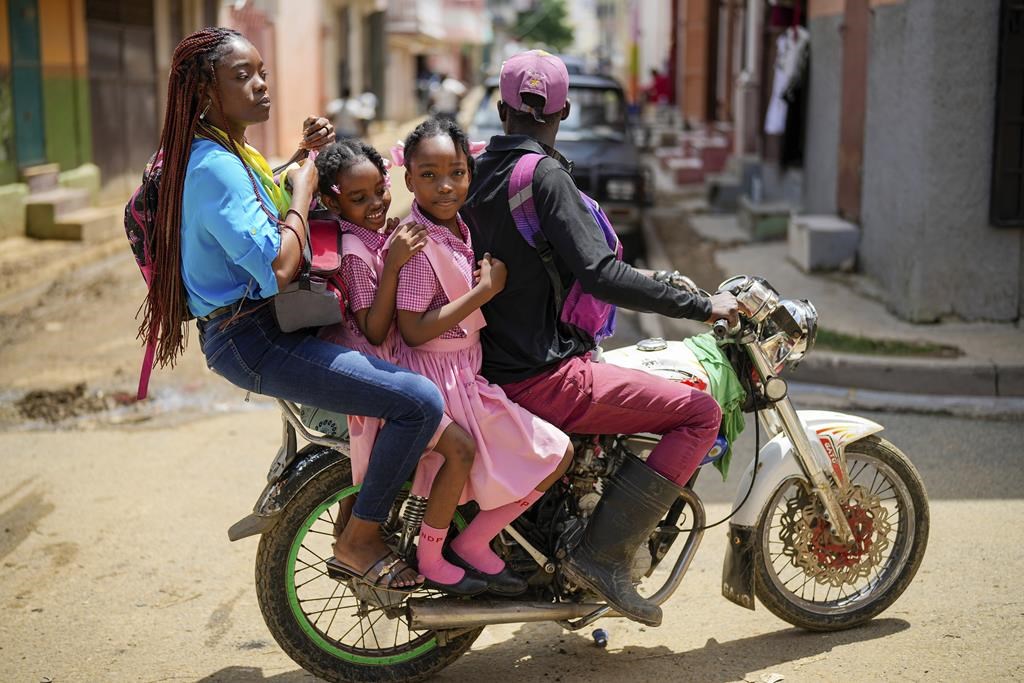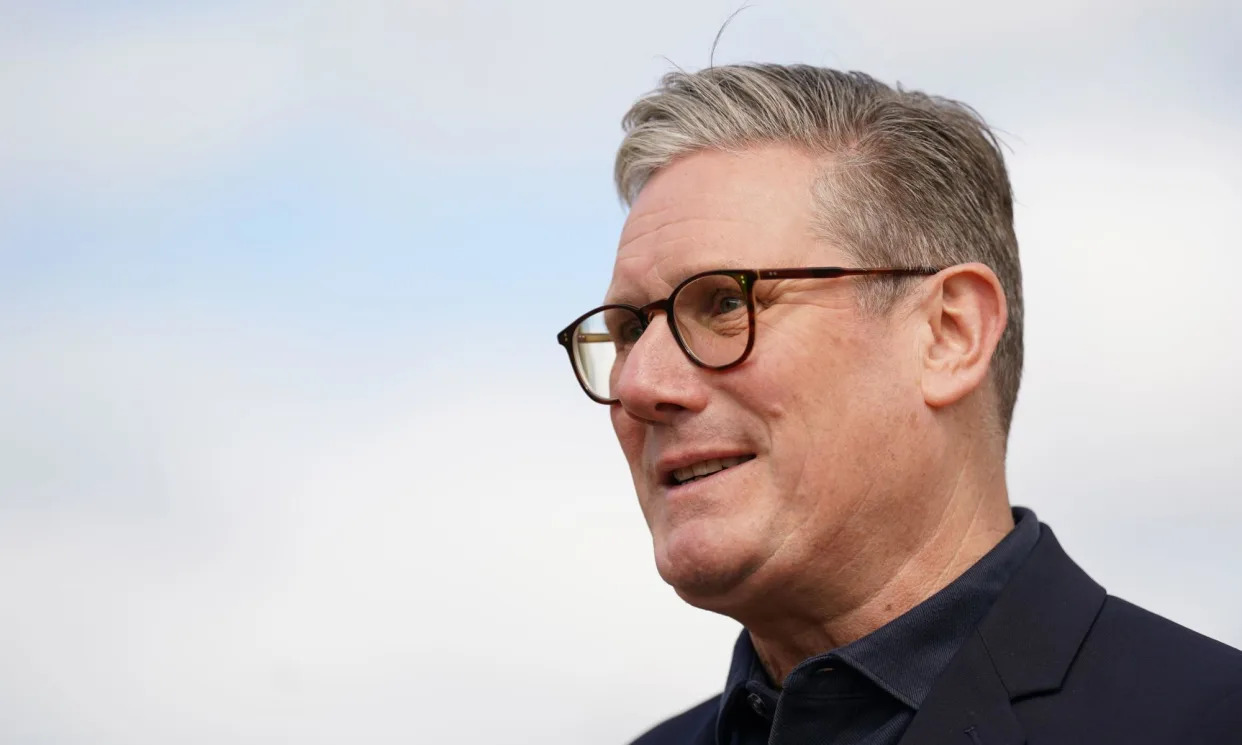A visitor walks next to the ‘Las Meninas a San Marco’ sculptures part of the installation by the Spanish artist Manolo Valdés, at the San Marco’s Square during the 60th Biennale of Arts exhibition in Venice, Italy, Tuesday, April 16, 2024. The Venice Biennale contemporary art exhibition opens Saturday for its six-month run through Nov. 26. The main show titled ‘Stranieri Ovunque – Foreigners Everywhere’ is curated for the first time by a Latin American, Brazilian Adrian Pedrosa. Pedrosa is putting a focus on underrepresented artists from the global south, along with gay and Indigenous artists. Alongside the main exhibition, 88 national pavilions fan out from the traditional venue in Venice’s Giardini, to the Arsenale and other locations scattered throughout the lagoon city.
A visitor looks the installation ‘Keepers of the krown’ by artist Lauren Halsey, at the Arsenale, during the 60th Biennale of Arts exhibition in Venice, Italy, Tuesday, April 16, 2024. The Venice Biennale contemporary art exhibition opens Saturday for its six-month run through Nov. 26. The main show titled ‘Stranieri Ovunque – Foreigners Everywhere,’ is curated for the first time by a Latin American, Brazilian Adrian Pedrosa. Pedrosa is putting a focus on underrepresented artists from the global south, along with gay and Indigenous artists. Alongside the main exhibition, 88 national pavilions fan out from the traditional venue in Venice’s Giardini, to the Arsenale and other locations scattered throughout the lagoon city.
Curator Aindrea Emelife watches the installation ‘Monument to the restitution of the mind and soul’ by artist Yinka Shonibare at the Nigerian pavilion at the 60th Biennale of Arts exhibition in Venice, Italy, Tuesday, April 16, 2024.The Venice Biennale contemporary art exhibition opens Saturday for its six-month run through Nov. 26. The main show titled ‘Stranieri Ovunque – Foreigners Everywhere’ is curated for the first time by a Latin American, Brazilian Adrian Pedrosa. Pedrosa is putting a focus on underrepresented artists from the global south, along with gay and Indigenous artists. Alongside the main exhibition, 88 national pavilions fan out from the traditional venue in Venice’s Giardini, to the Arsenale and other locations scattered throughout the lagoon city.
A visitor looks the installation ‘I will follow the ship by artist Matthew Attard at the Malta pavilion at the 60th Biennale of Arts exhibition in Venice, Italy, Tuesday, April 16, 2024. The Venice Biennale contemporary art exhibition opens Saturday for its six-month run through Nov. 26. The main show titled ‘Stranieri Ovunque – Foreigners Everywhere’ is curated for the first time by a Latin American, Brazilian Adrian Pedrosa. Pedrosa is putting a focus on underrepresented artists from the global south, along with gay and Indigenous artists. Alongside the main exhibition, 88 national pavilions fan out from the traditional venue in Venice’s Giardini, to the Arsenale and other locations scattered throughout the lagoon city.
BY COLLEEN BARRY
April 19, 2024
VENICE, Italy (AP) — Outsider, queer and Indigenous artists are getting an overdue platform at the 60th Venice Biennale contemporary art exhibition that opens Saturday, curated for the first time by a Latin American.
Brazilian curator Adriano Pedrosa’s main show, which accompanies 88 national pavilions for the seven-month run, is strong on figurative painting, with fewer installations than recent editions. A preponderance of artists are from the Global South, long overlooked by the mainstream art world circuits. Many are dead — Frida Kahlo, for example, is making her first appearance at the Venice Biennale. Her 1949 painting “Diego and I” hangs alongside one by her husband and fellow artist, Diego Rivera.
Despite their lower numbers, living artists have “a much stronger physical presence in the exhibition,” Pedrosa said, with each either showing one large-scale work, or a collection of smaller works. The vast majority are making their Venice Biennale debut.
Visitors to the two main venues, the Giardini and the Arsenale, will be greeted by a neon sign by the conceptual art cooperative Claire Fontaine with the exhibition’s title: “Stranieri Ovunque — Foreigners Everywhere.” A total of 60 in different languages hang throughout the venues.
READ MORE
Artist and curators refuse to open Israel pavilion at Venice Biennale until cease-fire, hostage deal
Demolition of groundbreaking Iowa art installation set to begin soon
Morocco hosts one of Africa’s first exhibitions of Cuban art, a milestone for Afro-Cuban painters
When taken in the context of global conflicts and hardening borders, the title seems a provocation against intransigent governments — at the very least a prod to consider our shared humanity. Through artists with underrepresented perspectives, the exhibition address themes of migration and the nature of diaspora as well as indigeneity and the role of craft.
“Foreigners everywhere, the expression has many meanings,’’ Pedrosa said. “One could say that wherever you go, wherever you are, you are always surrounded by foreigners. … And then in a more personal, perhaps psychoanalytic subjective dimension, wherever you go, you are also a foreigner, deep down inside.”
“Refugee, the foreigner, the queer, the outsider and the Indigenous, these are the four subjects of interest in the exhibition,’' he said.
Some highlights from the Venice Biennale, which runs through Nov. 26:
GEOPOLITICS AT THE BIENNALE
Facing the threat of protests, the Israel Pavilion stayed closed after the artist and curators refused to open until there is a cease-fire in Gaza and the Israeli hostages taken by Hamas are released.
Ukraine is making its second Biennale art appearance as a country under invasion; soft diplomacy aimed at keeping the world focused on the war. Russia has not appeared at the Biennale since the Ukraine invasion began, but this time its historic 110-year-old building in the Giardini is on loan to Bolivia.
For a short time during this week’s previews, a printed sign hung on the Accademia Bridge labeling Iran a “murderous terrorist regime,” declaring “the Iranian people want freedom & peace.” The venue for the Iranian pavilion was nearby, but there was no sign of activity. The Biennale said it would open Sunday — two days after the departure from Italy of G7 foreign ministers who warned Iran of sanctions for escalating violence against Israel.
LGBTQ+ ARTISTS
As a queer artist born in South Korea and working in Los Angeles, Kang Seung Lee said he identified with Pedrosa’s “invitation to look at our lives as foreigners, but also visitors to this world.”
His installation, “Untitled (Constellations),” which considers the artists who died in the AIDS epidemic through a collection of objects, is in dialogue with spare paper-on-canvas works by the late British artist Romany Eveleigh, who died in 2020. “The works speak to each other, an intergenerational conversation, of course,’’ said Lee, 45, whose works have been shown in international exhibitions, including Documenta 15. This is his first Venice Biennale.
Nearby, transexual Brazilian artist Manauara Clandestina presented her video “Migranta,” which speaks about her family’s story of migration. “It’s so strong, because I can hear my Daddy’s voice,’’ she said. Clandestina, who hails from the Amazon city of Manaus, embraced Pedrosa during a press preview marking her Venice debut. She said she continues to work in Brazil, despite discrimination and violence against transgender people.
NEWER NATIONAL PARTICIPANTS
The Giardini hosts 29 national pavilions representing some of the oldest participating nations, like the United States, Germany, France and Britain. More recent additions show either in the nearby Arsenale, or choose a venue further afield, like Nigeria did this year in Venice’s Dorsoduro district.
The Nigerian Pavilion, in a long-disused building with raw brick walls that exude potential, houses an exhibition that spans mediums — including figurative art, installation, sculpture, sound art, film art and augmented reality — by artists living in the diaspora and in the homeland.
“These different relationships to the country allow for a very unique and different perspectives of Nigeria,’’ said curator Aindrea Emelife. “I think that it’s quite interesting to consider how leaving a space creates a nostalgia for what hasn’t been and allows an artist to imagine an alternative continuation to that. The exhibition is about nostalgia, but it’s also about criticality.”
The eight-artist Biennale exhibition “Nigeria Imaginary” will travel to the Museum of West African Art in Benin City, Nigeria, where Emelife is curator, which will give it “a new context and a new sense of relevancy,’’ she said.
BREAKTHROUGHS
Ghana-born British artist John Akomfrah created eight multimedia film- and sound-based works for the British Pavilion that looks at what it is to be “living as a figure of difference” in Britain. Images of water are a connecting device, representing memory.
“In the main, I’m trying to tease out something about collective memory, the things that have informed a culture, British culture let’s say, over the last 50 years,’’ Akomfrah told The Associated Press. “As you go further in, you realize we’re going further back. We end up going to the 16th century. So it’s an interrogation of 500 years of British life.”
Considering the question of equity in the art world, Akomfrah indicated the adjacent French Pavilion — where French-Caribbean artist Julien Creuzet created an immersive exhibition — and the Canadian Pavilion on the other side, featuring an exhibition examining the historic importance of seed beads by Kapwani Kiwanga, who is in Paris.
“I mean, this feels like a very significant moment for artists of color,’’ said Akomfrah, who participated in the Ghana Pavilion in 2019. “Because I’m in the British Pavilion. Next to me is the French one, with an artist, Julien, who I love a lot, of African origin. And then next to me is a Canadian pavilion that has a biracial artist, again, with African heritage.
“So that’s certainly not happened before, that three major pavilions have artists of color inhabiting, occupied, making work in them. And that feels like a breakthrough,’' he said.
Rebecca Ann Hughes
Fri, 19 April 2024
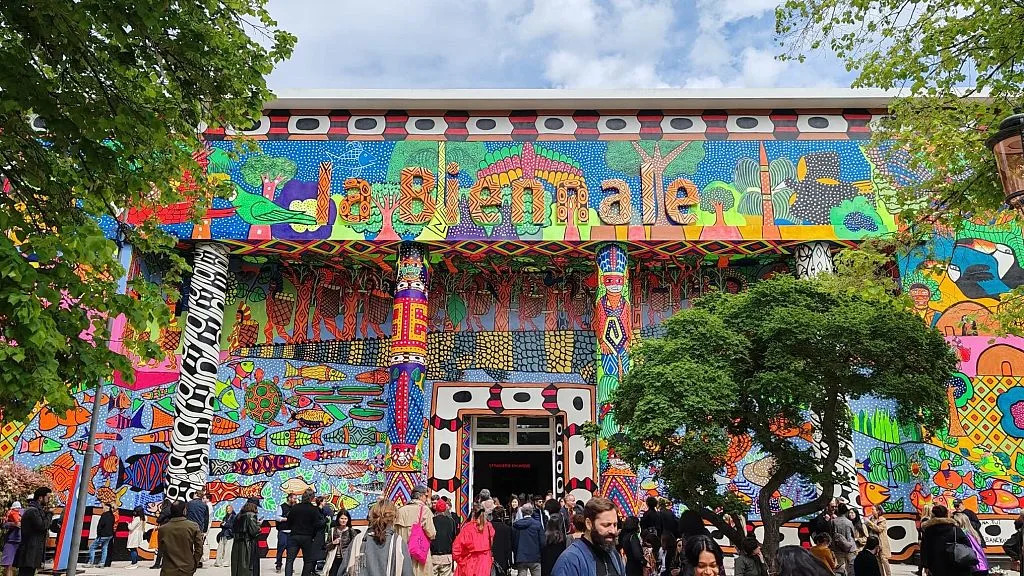
Foreign, national, indigenous: Venice Biennale 2024 grapples with geographic and personal identities
Entitled ‘Foreigners Everywhere’, the 2024 Venice Biennale has at its core the exploration of identity. The international show is notably - and for some anachronistically - organised into national pavilions.
Prompted by the theme, many countries have chosen to examine ideas of nationhood, belonging and foreignness. Collectively, however, this also raises the question of how valid the Biennale’s division of exhibitors into national showrooms continues to be.
‘You are always, deep down inside, a foreigner’

Roberto Cicutto and curator Adriano Pedrosa photographed together - Credit: Venice Biennale 2024
The 60th edition of the international exhibition, curated by Adriano Pedrosa, takes its title ‘Stranieri Ovunque - Foreigners Everywhere’ from the name of a Turin collective that fought racism and xenophobia in Italy in the early 2000s.
“The expression Stranieri Ovunque has several meanings,” explains Pedrosa. “First of all, that wherever you go and wherever you are you will always encounter foreigners - they/we are everywhere. Secondly, that no matter where you find yourself, you are always truly, and deep down inside, a foreigner.”
The curator’s exhibition is divided into two sections. The Nucleo Contemporaneo interprets the theme through the etymology of foreigner as ‘strange’.
“The exhibition unfolds and focuses on the production of other related subjects: the queer artist, who has moved within different sexualities and genders, often being persecuted or outlawed; the outsider artist, who is located at the margins of the art world, much like the self-taught artist, the folk artist and the artista popular; the indigenous artist, frequently treated as a foreigner in his or her own land,” says Pedrosa.
The Nucleo Storico, instead, gathers works from 20th-century Latin America, Africa, the Middle East and Asia. “We are all too familiar with the histories of modernism in Euroamerica, yet the modernisms in the Global South remain largely unknown,” says Pedrosa.
Pavilions grapple with the idea of nationhood
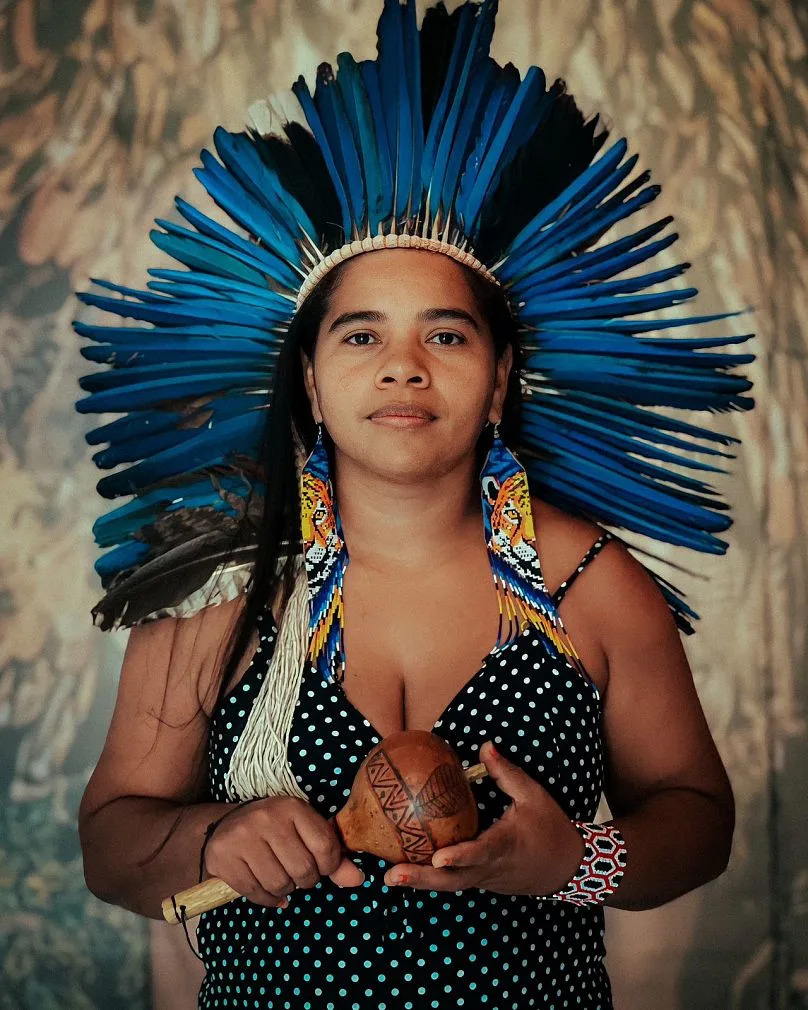
Glicéria Tupinambá - Credit: Fundação Bienal de São Paulo
At the heart of several national pavilion exhibitions is the complex and often controversial concept of nationality and belonging. Many deal with the notion of multiple distinct national identities and give a voice to those historically marginalised. The Australia pavilion gives the floor to First Nation artist Archie Moore, whose exhibition will highlight the gulf between Australia’s 254-year history and the 65,000+ year context of his Aboriginal family heritage.
Glicéria Tupinambá will represent Brazil as well as her community of Tupinambá Indigenous people. Her exhibition, titled Ka’a Pûera: nós somos pássaros que andam (Ka’a Pûera: we are walking birds), will showcase the richness of the Tupinambá culture and its story of reclamation and resurgence amid persistent marginalisation.

Photo exhibited at the Danish Pavilion from Storch's series Porcelain Souls - Inuuteq Storch
Denmark’s pavilion will feature Greenlandic artist Inuuteq Storch. His installation titled Rise of the Sunken Sun will juxtapose raw, intimate historical and family photographs with contemporary snapshots of the everyday in order to “tell the Greenlanders’ visual history, not seen through the visitors’ eyes, but through the Greenlanders’ own.”
For France, Julien Creuzet will delve into his own French-Caribbean identity. “His singular work and his gift for oral literature feed on creolisation by bringing together a diversity of materials, stories, shapes and gestures,” according to a press release. “Creuzet was also chosen for the horizons he draws, going beyond the opposition between identity and universality, demonstrating that in the folding of art, the poetic and artistic echoes always trace responses that are as beautiful, joyful and restorative as they are unexpected.”
At Chile’s show, Valeria Montti Colque will instead explore the idea of multi-sited nationhood and connections beyond borders. Born in Stockholm in 1978 after her family was exiled during Chile’s military dictatorship, the artist draws on anthropologist Michel S. Laguerre’s theories of diasporic communities and their relationship with their ancestral lands.
Venice exhibitions interpret the concept of foreignness

Inside the Arsenale exhibition site of the Venice Biennale 2024 - Credit: Rebecca Ann Hughes
Other pavilions have picked up the equally undefinable concept and often perturbing feeling of foreignness instead. Making its debut this year, the United Republic of Tanzania will feature a group exhibition with artists Happy Robert, Naby, Haji Chilonga, and Lute Mwakisopile curated by Enrico Bittoto. It will trace the evolution of the concept of the ‘other’ and consider themes of travel, encounters and re-definition of self.
For Serbia, artist Aleksandar Denić echoes the history of the pavilion building, which has passed between multiple nations, in an installation about residency and transit. He himself is permanently displaced in Germany and prompts the visitor to muse over the meaning of belonging and the sensation of being a foreigner in your own country.
Venice Biennale 2024 announces lineup of 331 artists showcasing Queer and Indigenous art
Pancaked Popes & bananas: What is the Vatican’s surprising choice for the Venice Biennale?
In North Macedonia’s pavilion, Slavica Janešlieva invites visitors to experience feeling like a stranger through a multimedia installation using neon signs, mirrors, feathers and other materials.
With so many pavilions dedicated to the question of national identity and its historical and enduring complexities, attention is also drawn to the Biennale’s own rigid division into national pavilions. Perhaps it's time for a different model that is less geared towards national introspection and more towards international connectedness and dialogue.
The 60th Venice Biennale, curated by Adriano Pedrosa, runs from Saturday 20 April to Sunday 24 November.
Venice Biennale: our picks of the shows to see in Venice from John Akomfrah to Ethiopia's first ever pavillion
Elizabeth Gregory
Sat, 20 April 2024

Listening all Night to the Rain, John Akomfrah at the British Pavilion (Venice Biennale 2024)
The Venice Biennale begins today, thrilling art fans around the world. The seven-month-long, biannual, city-wide exhibition, will present astonishing and illuminating works of hundreds of artists from around the world.
For those planning to head to Italy’s glorious floating city, there’s more than a lot of material to get through: 331 artists will show work in the central exhibition, Foreigners Everywhere, which has been curated by Brazilian art director Adriano Pedrosa.
There are also 88 countries with National Pavilions, 30 official Collateral Events and many, many other concurrent exhibitions running throughout the city.
So with so much to do and so little time, here are some of our top recommendations.
The Pavilions
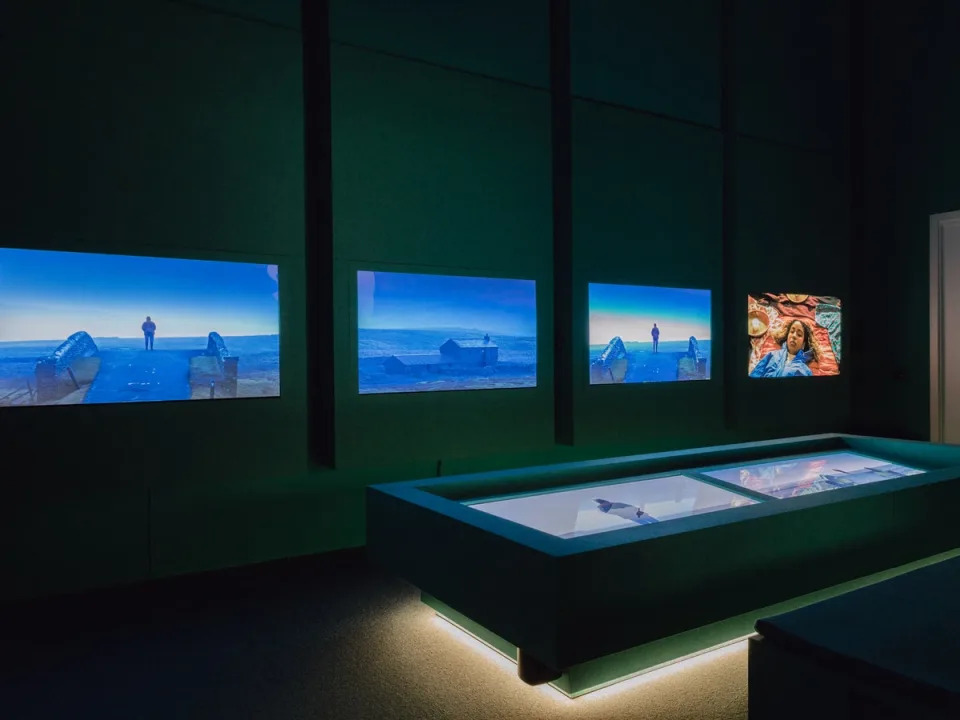
Listening all Night to the Rain, John Akomfrah at the British Pavilion (Venice Biennale 2024)
Australia: kith and kin, Archie Moore
Archie Moore is exploring genealogy and commemoration of Indigenous lives in Australia’s pavillion. Wholly in shades of black and white, the space’s walls are filled with a hand-drawing of Moore’s family tree. His heritage is Aboriginal, so the tree extends back some 65,000 years, a figure which looms large, both literally and metaphorically, over the 254 years of modern Australia’s existence. Moore has said the site is for “quiet reflection and remembrance.”
Britain: Listening all Night to the Rain, John Akomfrah
The pioneering British filmmaker, who founded the Black Audio Film Collective in 1982, has built a reputation for creating extraordinary, thought-provoking films. His pavilion piece, an exploration of post-colonialism and environmental devastation, runs across six connecting video installations. One paper called it “unhinging, sorrowful and utterly captivating”; another called it “a jumble of gibberish”.
For those who can’t make Venice, the British Council-commissioned work will tour the UK in 2025, with confirmed stops at Cardiff’s National Museum and Dundee Contemporary Arts.
Croatia: By the Means at Hand, Vlatka Horvat
Visual artist Vlatka Horvat’s piece at the Croatian Pavilion is a dialogue between artists. She has invited some of her friends from around the world to contribute pieces that deal with experiences of living away from home. The twist here is that the works won’t be sent via postal services, but will be brought by friends, colleagues and acquaintances travelling to Venice. The result, as the pieces slowly arrive, will be a continually changing exhibition, a meditation on friendship, community and trust.
Ethiopia: Prejudice and belonging, Tesfaye Urgessa
With 2024 marking Ethiopia’s first National Pavilion, it’s no great surprise that the work of its chosen artist, celebrated Ethiopian painter Tesfaye Urgessa, promises to be a standout. Urgessa’s distorted human figures, often depicted in surreal, domestic settings, seem to ask questions about the human psyche, intimacy, memory and identity.
Foreigners Everywhere
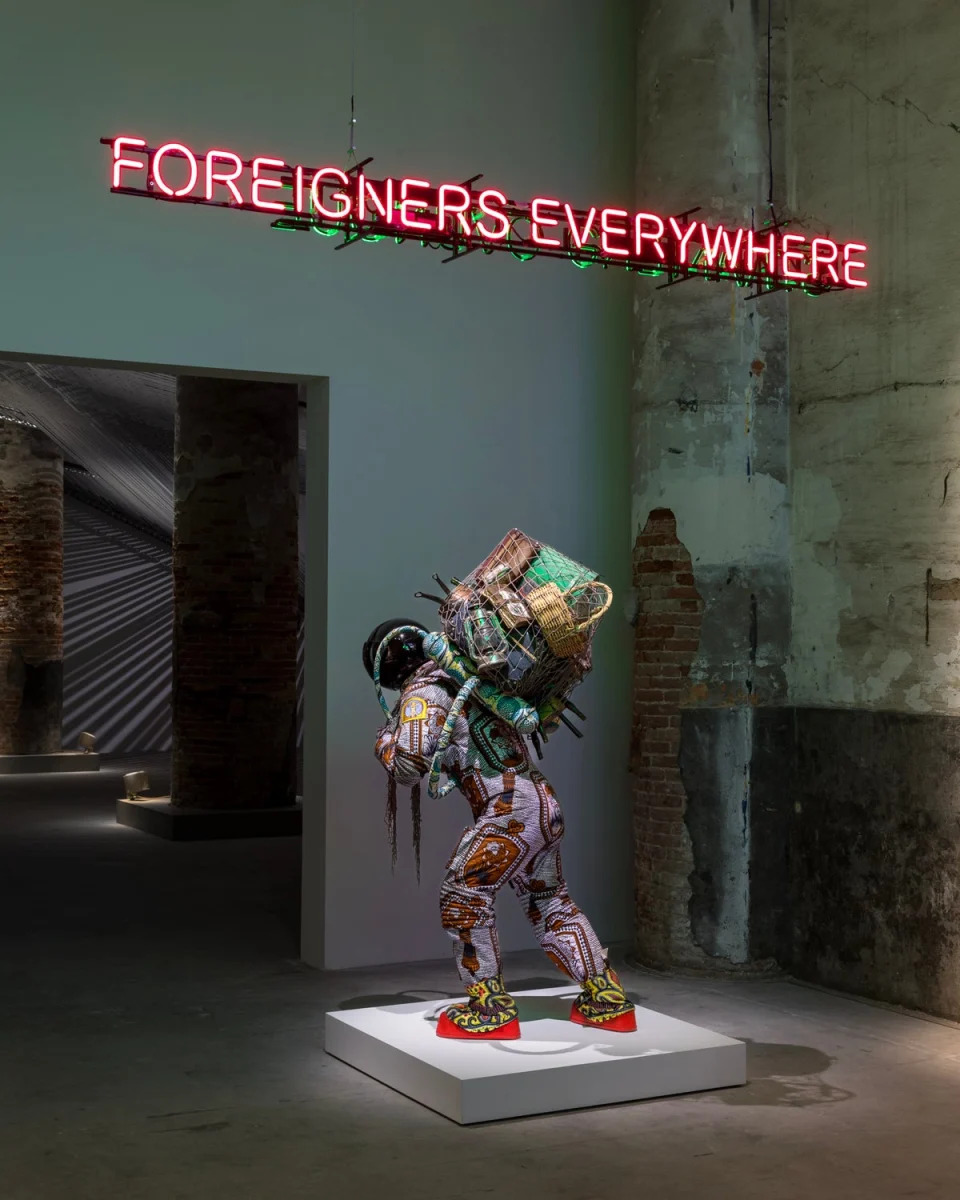
Yinka Shonibare in Foreigners Everywhere, photo by Marco Zorzanello (Venice Biennale 2024)
This year’s central exhibition, which has been curated by Pedrosa, is set to be a real humdinger. The first-ever Latin American curator is shining a light on artists from the global majority – many of whom are relatively unknown in the West, and have typically enjoyed less exposure at Venice.
“In the last decade or so it has become unthinkable that you might do a Eurocentric biennale of contemporary art,” he said to the FT. “We haven’t seen the same rules applied to historical shows, so I wanted to look at Modernism in South America, Africa, Asia, and how Modernism travelled in the 20th century.”
The exhibition, which boasts 331 artists, will also include the work of Lebanese-American poet Etel Adnan, trailblazing modernist painter Judith Lauand, and the celebrated Yinka Shonibare, whose work is also being shown in the Nigerian Pavilion.
Other
William Kentridge: Self-Portrait as a Coffee-Pot

South African artist William Kentridge (AFP via Getty Images)
South African artist William Kentridge, now 68, has spent his career exploring social injustice, conflict and political oppression in a variety of media including tapestries, prints and drawings, sculptures and animated films. In Self-Portrait as a Coffee-Pot, a new nine-episode video series, he collaborates with friend and curator Carolyn Christov-Bakargiev and muses on living in the digital age.
“I love his work,” says Jenny Waldman, the director of Art Fund. “This is a series he did during lockdown, so it’ll be very interesting to have a look at what he’s up to at the moment.”
Arsenale Institute for Politics of Representation, to November 24; arsenale.com
Crip Arte Spazio: The DAM in Venice
The first-ever major international exhibition of the UK Disability Arts Movement (DAM) is not one to miss: it’s set to be a joyous and high-spirited affair, bringing together artists including Terence Birch, Tony Heaton, Jameisha Prescod, Ker Wallwork, Tanya Raabe-Webber, Jason Wilsher-Mills and Abi Palmer. Palmer’s 2023 Artangel [the London-based arts organisation] commission, Abi Palmer Invents the Weather, will be included in the exhibition.
CREA, Venice; shapearts.org.uk
Non-contemporary
Carpaccio at the Schiavoni
“If you've had enough of the contemporary art as you go around, the museums and churches in Venice are just incredible,” says Waldman, who recommends taking some time to see the canvases painted by Vittore Carpaccio (1465-1526) which hang in the Scuola di San Giorgio degli Schiavoni – particularly the 516-year-old St George and the Dragon.
“It's one of the most spectacular pieces,” she says. “It's in a lovely room with Carpaccio paintings around four walls. You can have a quiet afternoon sitting there.”
Jenny Waldman’s insider tips for doing Venice right

Jenny Waldman
The Biennale veteran and director says that Venice is “a shared journey of discovery, a little bit like an Olympic marathon” – the hours of traversing the city are part of the fun.
Download the Bloomberg Connects app
The Bloomberg Connects app, says Waldman, is the best way to get around. Download it onto your mobile for seamless navigation of the city-wide exhibition. Not only does it have the pavilions, Collateral Events and central exhibition all marked on a map of Venice, but it includes artist and exhibition descriptions that can be searched through QR codes or numbers that are dotted around the city.
Buy a battery pack
But of course, the app will only work if the phone is actually turned on, and as Waldman hints at, phones will be getting a lot of use. So make sure to fully charge your mobile before you leave the house, and bring an extra (charged) battery pack for good measure.
A sturdy pair of shoes
It seems simple enough, but with Venice inspiring you to put on your finest, it’s important to remember the step count you’re about to tot up over the coming days – exhibitions really do stretch from one side of the city to the other. But fear not – you don’t have to abandon all sartorial considerations; loafers will do.
Venice Biennale, April 20 - November 24; labiennale.org
‘No death in Venice’: Israel-Gaza tensions infiltrate biennale
Charlotte Higgins in Venice
Fri, 19 April 2024
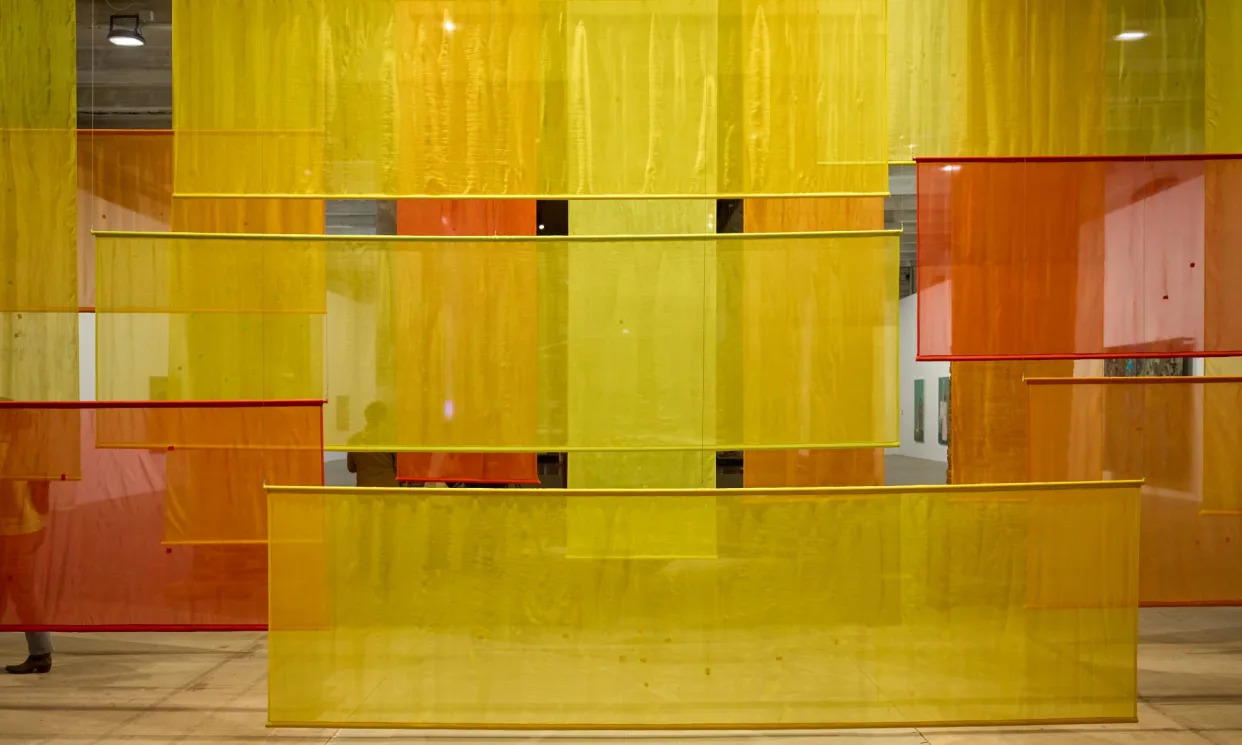
Come, Let Me Heal Your Wounds. Let Me Mend Your Broken Bones by the Palestinian artist Dana Awartani. Photograph: David Levene/The Guardian
Billionaires’ yachts and protests; cocktail parties and culture wars; bellinis and boycotts. The Venice Biennale’s opening preview days are always a place of odd clashes and juxtapositions, as artists, curators, critics and wealthy collectors descend on the city to take in often politically radical art.
But this year’s edition vibrates with particular uncertainty and tension – even, perhaps, an end-of-days atmosphere. The biennale, which this year stages exhibitions from 88 national pavilions, has been touched by political currents that originate far beyond the lapping waters of the Venetian lagoon.
Police equipped with riot shields are not an ordinary sight in Venice’s Giardini, one of the main venues for the biennale. But this Wednesday, they were there – as were protesters, shouting “Viva Palestina” and handing out leaflets with the text “No death in Venice”. Under the banner of Anga – short for “art not genocide alliance” – a collective of artists and creatives were calling for a boycott of the Israel pavilion, in the light of the escalating conflict in Gaza. “We demand the boycott of the Israeli pavilion. We demand the biennale shut it down,” read the leaflets. A flashmob descended not only on the Israel pavilion, but also the pavilions of the US, UK, France and Germany.
The biennale did not shut it down. And, by then, the official Israeli artist, Ruth Patir, had made the decision not to open her exhibition, leaving the national pavilion presided over by Italian military. A poster fixed to the window stated it would remain closed until “a ceasefire and hostage release agreement is reached”.
Related: Insider art: Vatican sets up Biennale pavilion at Venice women’s jail
Yael Bartana, another prominent Israeli artist, who has never represented her homeland in the biennale but in 2011 represented Poland and this year has a work in the German pavilion, lamented what she saw as a narrowing gap for subtle expression in an increasingly polarised environment. “Unfortunately, at the moment there is no space for manoeuvre and ambiguity. I’m always questioning the idea of nation states, belonging, my own identity,” said the artist, who is based in Berlin and Amsterdam.
Her film for the German pavilion uses sci-fi tropes to create an end-of-days story of humanity leaving Earth – perhaps to start afresh away from the traumas created by modern nation states – in a spacecraft whose design is based on the kabbalistic tree of life. “Everyone I know wants a ceasefire and the hostages released. The artist and curators [of the Israel pavilion] have my respect for taking what must have been a very tough decision,” she said.
There is Palestinian work present at the biennale. In the main, centrally curated exhibition, organised by the Brazilian curator Adriano Pedrosa, is a delicate but large-scale sculptural textile work by Dana Awartani, made from strips of silk which she rips – representing bomb damage in Gaza – before painstakingly darning the tears. Come, Let Me Heal Your Wounds. Let Me Mend Your Broken Bones, is its title.
Healing and resilience is also a leitmotif of an official “collateral” event, South West Bank, featuring work by Palestinian artists. “Using art to heal is what we have always done,” said one of them, Dima Srouji. “Now the art can speak for itself for the first time as everyone is finally listening.” Her work, made with Jasbir Puar, an academic, is called Untitled (Onion Masks). It consists of a reproduction of a photograph from 1940 showing Australian soldiers in Gaza wearing gas masks while peeling onions, combined with delicate blown-glass sculptures. The work refers to the practice of modern Palestinian protesters of incorporating onions into improvised masks to protect them from teargas.
Elsewhere in the biennale, other conflicts come into focus. Ukraine’s pavilion shows, among other works, an hour-long film of shaky civilian-shot phone footage of terrifying events unfolding on Ukrainian streets, put together from thousands of clips by the artists Daniil Revkovskyi and Andrii Rachynskyi. The Ukrainian team are also responsible for the posters cropping up around the city showing maps of the nearest bomb shelter, just in case. (It turns out that Venice has one, “permanently closed” as the map declares, very near to the Ukrainian pavilion in the city’s Arsenale.)
Even when war is not the subject, themes of decolonisation, migration, and dispossession seem omnipresent, from John Akomfrah’s beautiful but unsettling epic video work for the UK pavilion, to Archie Moore’s meditation on Aboriginal erasure and colonial injustice in the Australian pavilion. These ideas chime with the title of the biennale, Stranieri Ovunque – Foreigners Everywhere, in which Pedrosa has created a central exhibition teeming with work from the global south, focusing on queer and Indigenous artists in particular.
Some see this as a culmination of sorts. In two years’ time, the next curator will have been appointed by the new president of the Venice Biennale, the provocative rightwing intellectual Pietrangelo Buttafuoco – himself nominated by Giorgia Meloni’s government. Whatever political or social change is on its way, the biennale, as ever, is likely to reflect it – or even predict it.
The Venice Biennale runs from 20 April to 24 November.
CBC
Sat, 20 April 2024

An outside view of Kapwani Kiwanga's exhibition Trinket at the Canada pavilion at the Venice Biennale. (Valentina Mori - image credit)
Over the years, 60 Canadian artists have won the honour of showing their work in a small, angular, wood-and-glass pavilion that sits on the end of the Venice lagoon.
But this is the first time an artist has draped the pavilion in luscious strings of cobalt-blue beads that shift and soften the outline of the building.
The beads provide the opening glance of Trinket by Hamilton-born, Paris-based artist Kapwani Kiwanga, Canada's representative at this year's Venice Biennale, the world's most prestigious art show.
In her exhibit, Kiwanga literally and metaphorically connects the dots — glass bead by glass bead — of trade that radiated out around the globe from Venice, once one of Europe's most important ports, and the impact that had.
For centuries, the beads, called conterie, were produced on the nearby glassmaking island of Murano and used as currency and for barter, taking off in the 16th century as European traders and explorers expanded their global reach.
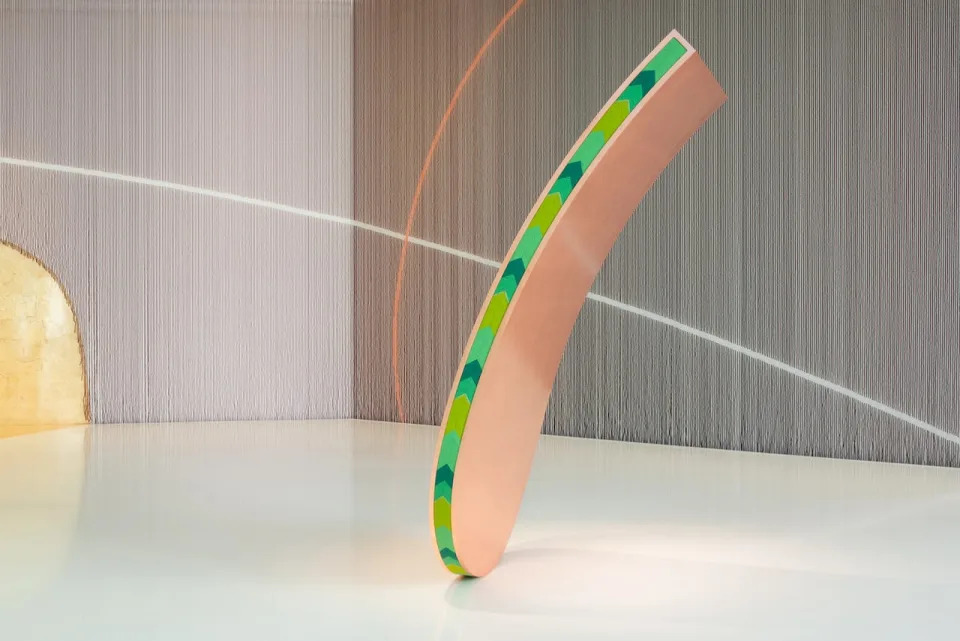
Transfer III (Metal, wood, beads), 2024, made of wood, Pernambuco pigment, copper and glass beads.
Transfer III (Metal, wood, beads), 2024, made of wood, Pernambuco pigment, copper and glass beads, by Kapwani Kiwanga. (Valentina Mori)
"These little, tiny, miniscule units of glass shaped our modern and postmodern world," said Kiwanga from her studio in Rome before the opening of the Venice Biennale on April 20.
"I'm interested in how materials can be documents themselves of human, social and political interaction."
As chance would have it, the very same year she was selected to represent Canada in the Biennale, commissioned by the National Gallery of Canada, she's been living in Italy as an artist-in-residence at the beautiful Villa Medici, part of the French Academy, near the top of the Spanish Steps in Rome.
Interest in power imbalances
The conterie, from the Portuguese word "to count," were exchanged for everything from tropical wood to gold that was brought to Europe and used to construct and adorn everything from chairs in homes to soaring cathedrals.
In the South American and African communities the beads were traded, though, they disrupted local economies and social cohesion, says Kiwanga, whose work is concerned primarily with power imbalances, from the geopolitical to the institutional.
Inside the pavilion, the walls are adorned with more conterie, these ones inlaid with different raw materials that were once exchanged for them — Pernambuco redwood from Brazil, gold leaf and metal. Four sculptures of the same material inlaid with beadwork form physical and narrative points of contact.
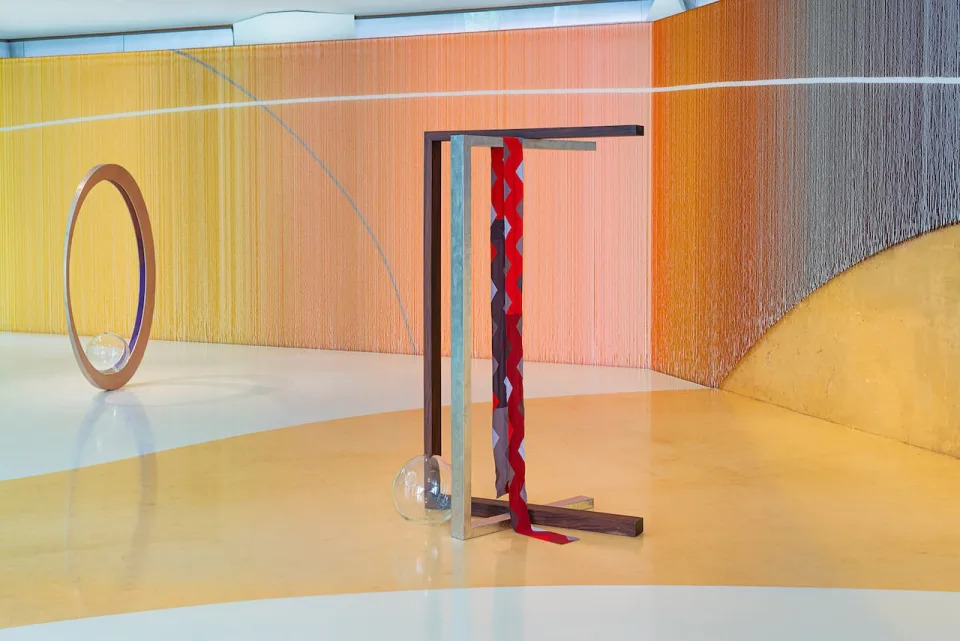
Transfer II (Metal, breath, beads) and Transfer IV (Metal, wood, breath, beads) , 2024 bronze, blown glass, glass beads ; bronze, palladium leaf, wood, blown glass, glass beads
Transfer II (Metal, breath, beads) and Transfer IV (Metal, wood, breath, beads), 2024, made of bronze, blown glass, glass beads and bronze, palladium leaf, wood, blown glass, glass beads, by Kapwani Kiwanga. (Valentina Mori)
Kiwanga, who is now in her mid-40s, grew up in downtown Hamilton in a working-class family with roots in Zimbabwe. Her mother was the one who exposed her to art — from the mosaics at Hamilton City Hall and paintings and sculpture at the Art Gallery of Ontario to museums when they travelled — while her family encouraged her to value personal expression over the pursuit of wealth.
"I've never had this pressure of financial success, and that defined for me quite early what freedom meant: being able to choose what I wanted to do," she said. "It was a great gift."
Early schooling
The idea to become an artist didn't come until her mid-20s, after she studied anthropology and comparative religion at McGill University in Montreal and worked for a few years as a documentary filmmaker in Scotland.

Raised in Hamilton, Kapwani Kiwanga is Canada’s representative at the 2024 Venice Biennale.
Raised in Hamilton, Kapwani Kiwanga is Canada’s representative at the 2024 Venice Biennale. (Angela Scamarcio)
"I found it a bit too limiting for me," she said of film, and the idea of not being able to have a full say in the final cut. "But I didn't really know what art was, so it was really just this open question: could this be a space, and what could I make of it?"
Kiwanga won a small scholarship to attend the Beaux Arts de Paris for two years, followed by another two-year postgraduate program in the north of France. Those four years "of exploring," as she calls them, convinced her to make a go of it as an artist.
The choice has paid off, both in terms of freedom and recognition. Kiwanga has exhibited at top galleries around the world and won international prizes, including France's prestigiousPrix Marcel Duchamp, which came with 35,000 euros for her installation Flowers for Africa at the Centre Pompidou in Paris, Canada's Sobey Art Award and the U.S.-based Frieze Artist Award.
Before becoming an artist, she was tempted to become a scholar, but wanted a wider audience for her work. Still, the drive to go deep is core to her art.
"I just ask myself a question and then I say, 'Well, who's thought about this as well?' and then read people who have dedicated decades to research an area, and then ask more specific questions," she said.
What emerges from those questions, and the creative shaping that follows, are spacious, abstract works that elegantly synthesize complex histories and ideas.
They take the form of everything from wafting, diaphanous, desert-coloured sheets and gleaming sculptures to pairing colours used by industrial designers to create moods or control movement in offices, psychiatric wards and prisons.
In Trinket, as well as inan exhibit that was part of a group show at the last Venice Biennale, Kiwanga often hones in on a particular aspect or material related to colonial and mercantile economies. That could be containers, sisal, sand and glass, as well as floral arrangements she recreated from diplomatic dinners that were part of African nations' bid for independence.
In other exhibits, she's explored racialized surveillance, featuringpolice floodlights melted down into tiny beads to form a massive metallic veil, inspired by the writing of American scholarSimone Browne.
'There are many layers of my person'
While race is at times part of her work, it's one of many aspects related to power imbalance that she explores. She says being the first Black female artist to show at the Canadian pavilion in Venice doesn't hold much meaning for her.
"If it's important for other people to [use] these labels and be interested in the firsts, then that's fine, it's their narrative," she said. "Just doing one's work and existing is what I'm interested in. There are many layers of my person and it's sometimes hard to see it essentialized or simplified."
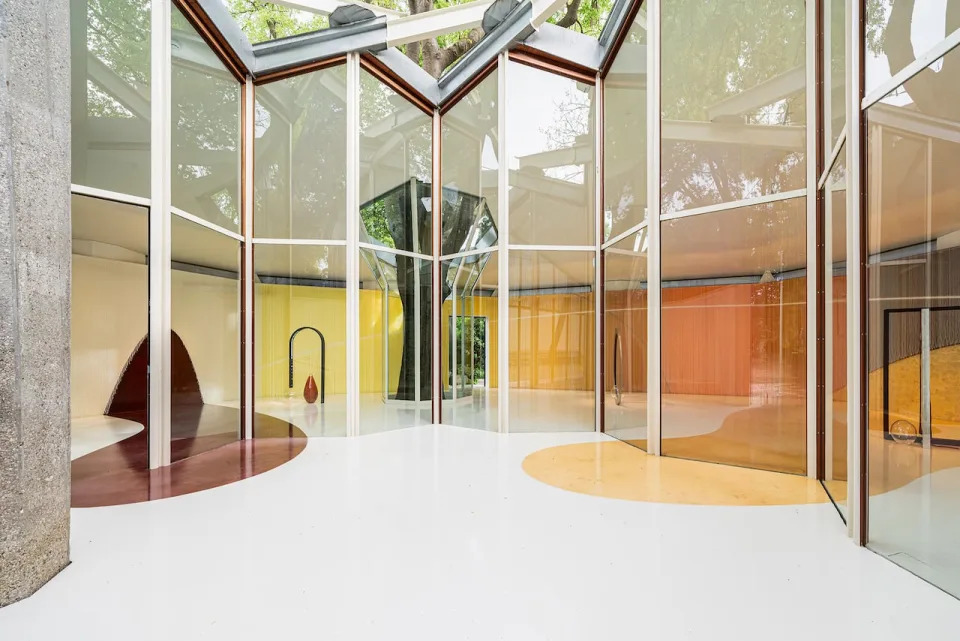
An outside view of Kapwani Kiwanga's exhibit Trinket at the 2024 Venice Biennale.
An outside view of Kapwani Kiwanga's exhibit Trinket at the 2024 Venice Biennale. (Valentina Mori)
Despite her international success, she says she gives little thought to strategy in an art world that has largely ignored female talent and, until recently, all but shut out Black artists. She says her family's emphasis on freedom — that as long as you can pay the rent, do what you love — still shapes her life choices.
"I just really go with what I desire, my love of things, my interest, my curiosity," she said.
"I have very little expectations, but I have a lot of ambition in terms of the work. After that, the rest is kind of noise. It's other people's game."

 Over 100,000 Haitians flee Port-au-Prince the past 30 days
Over 100,000 Haitians flee Port-au-Prince the past 30 days